Q&A – Ask Neil: August 4, 2022
(Please read these instructions carefully.)
We’ve received really nice comments on this much-expanded way of addressing questions I’m asked. Before you post your own question, I might suggest you look at recent issues to see if someone else has already asked it. You might find your answer there.
• Click here to post your question.
• After you submit your question, a new window will pop up giving you the address to which you can e-mail a photo to accompany your question. Clear, medium-resolution photos. (Try to avoid low-res thumbnail photos, please, in case I have to zoom in to see things.)
• Please only post your question one time.
• One question per reader, please.
• Please use this only for posting questions – not for standard emails.
• Watch for your answer in the following week’s e-gardens.
• I choose those of greatest general interest. For example, plant IDs seldom make the cut.
• I must have your first name or initials.
• I must have your city or county. (Texas is a very large state.)
QUESTION 1
WHAT HAS EATEN MY MEXICAN PLUM’S LEAVES?
Question: I have a Mexican plum with holes all through its leaves. I’ve applied Sevin as well as a combination fungicide/miticide/insecticide. The destruction continues. What is eating the leaves? Sam G., Cedar Hill.
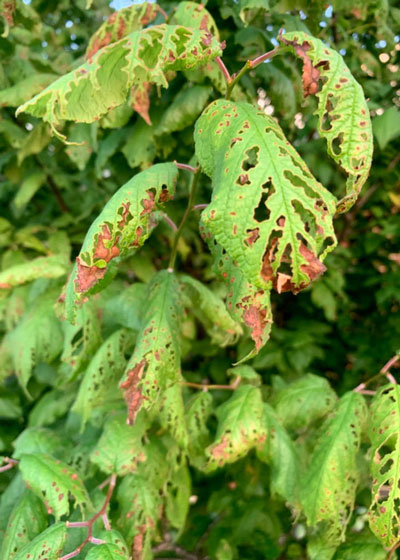
Answer: I’m not sure, although I’ve spent 30 minutes trying to find any kind of reference online. There is just so little written about Prunus mexicana and the possible insect and disease problems that might attack it. I found information on borers, bacterial stem canker, standard fruit pests and other things, but not what I wanted. From my early training, I thought that when you saw holes with some of the flaps of dead leaf tissue hanging that you were probably looking at bacterial leaf spots and a “shot-hole” effect. But I didn’t see any information that I wanted to pass on to you. It’s also noteworthy that the holes are symmetrically arranged. So, I’ll keep looking. The good news is that this does show up on Mexican plums fairly often, also on domesticated plum varieties. Just not this badly. Having witnessed this before, my guess is that your tree will probably be fine come next spring.
QUESTION 2
WHAT SHOULD I DO WITH THIS FIG PLANT?
Question: When my fig leafed out this spring it only had leaves at the ends of its branches. It bore a few figs, but animals got all of them. Should I trim it back considerably next spring? Pam M., Spring Branch, Comal Co.
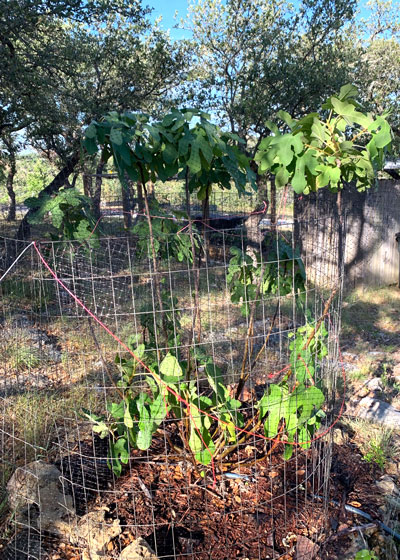
Answer: Yes, on pruning it significantly, and yes on doing it in early next spring so it can get its new growth underway right away. It’s too late in this growing season to do so. This plant has probably been hurt badly by one or both of the last two winters. They were brutal to plants that are known to be a bit tender. That would include figs.
QUESTION 3
IS THIS A FUNGUS ON MY AZALEAS?
Question: My azaleas are dying. They have red, crusty looking leaves and I’m wondering if this is caused by a fungus. What can I do? Van R., Farmers Branch.
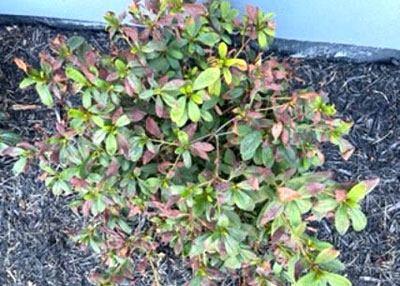
Answer: It’s really hard to tell from the photo, but that doesn’t look like any fungus I’ve ever seen on an azalea. I’m pretty sure either the plants have gotten too dry (or too much sun) or that they’re planted in something less than ideal azalea mix. Azaleas need to be planted into beds that are 18 inches deep, half above grade and half below grade, consisting exclusively of sphagnum peat moss and finely ground pine bark mulch in equal amounts. You’re in the Blackland Prairie, and those soils are highly alkaline. Azaleas require just the opposite.
QUESTION 4
WHAT IS KILLING THE GRASS?
Question: I’ve applied insecticide according to directions, but this area still looks bad. It started last summer. I can’t see any chinch bugs so I’m wondering if this is a fungus. Debbie J., The Colony.
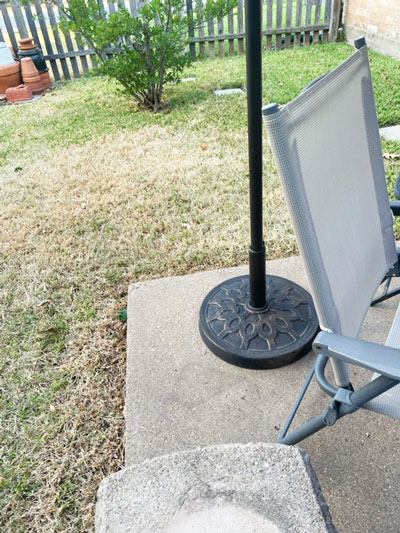
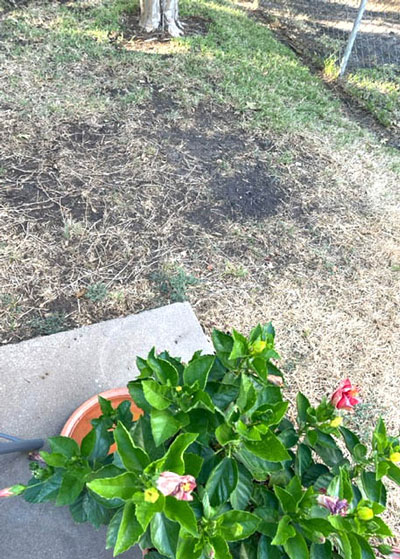
Answer: Since you mentioned chinch bugs, I’m going to refer you to the lengthy discussion. I posted on my website 6 or 7 weeks ago regarding St. Augustine diagnostics. It’s difficult to see any specific details in your photos so I’ll let you do some reading up via what I’ve posted. However, this looks more like dry grass and excessive shade than chinch bug damage. In honesty, the photo that does not have the potted hibiscus: I thought I was looking at bermudagrass. Chinch bugs would not be involved in bermuda at all. I need more facts.
QUESTION 5
WHAT CAN I USE TO REPLACE THESE PLANTS?
Question: I need to replace these green arborvitae that look like toast now. My hedge (don’t know its name) is also dying, so I’ll need to replace it as well. Joanna M., Dallas.

Answer: This is the perfect time to meet with a landscape designer at a local independent retail garden center (not one of the national big box stores) to draw up a new landscape plan for your backyard. First, he or she will know the tools (plants) that will do best in your area and that won’t face tons of insect and disease issues. Second, he or she will know to develop beds that will soften the harshness of the straight lines of the fence. You want to develop curved beds 5 to 9 feet out away from the fence. That will let you plant in more natural clusters and groupings of three to seven plants of each species. Try to avoid straight lines and formal shearing. Your nursery professional will have lots of fun ideas, and fall is the best time of the entire gardening year to get new plants started.
QUESTION 6
WHAT IS WRONG WITH MAIDENGRASS?
Question: I planted 5-gallon maidengrass plants in September, 2019. The holes were dug deep and wide. I’ve been doing heavy hose watering once per month. Could this be root rot? Mike C., Grapevine.
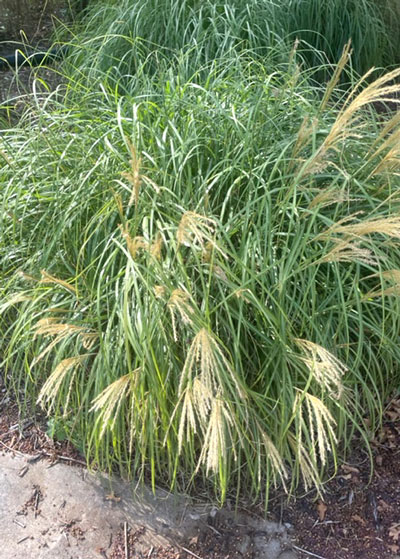
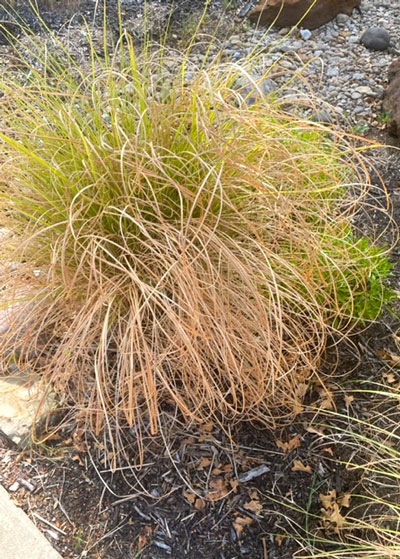
Answer: These plants have gotten way too dry. Step up the watering to every 5 days and soak them deeply. This is all about watering.
QUESTION 7
WHY DOES REDBUD HAVE BARE BRANCHES?
Question: Why does my redbud have several bare branches, while other branches have green leaves? What can I do?
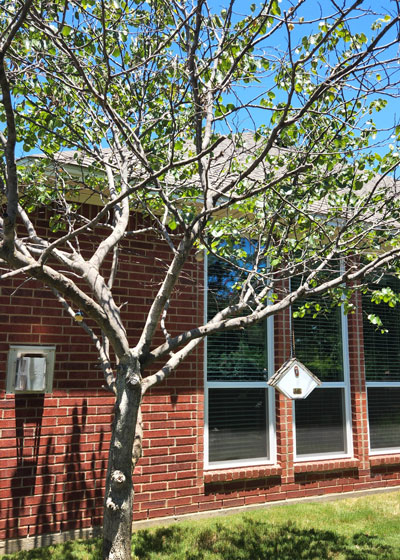
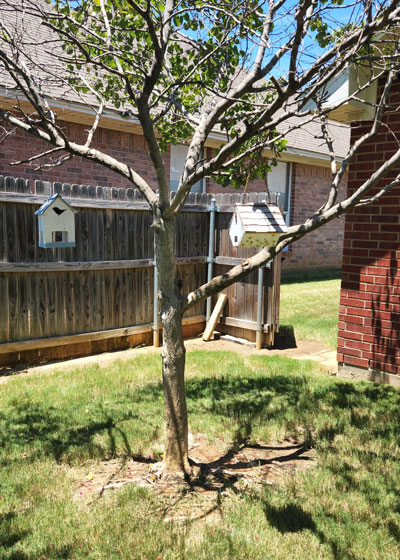
Answer: I’m seeing small cracks in the trunk when I lighten and zoom in on it. That might indicate freeze damage from the past two winters (even though redbuds are normally quite winter-hardy). Look, too, for pencil-lead-sized holes in the trunk. They would indicate exit holes of redheaded wood borers. They’re common invaders of troubled redbuds. This behavior for redbuds is not uncommon when they are challenged by climatic extremes. There isn’t much you can do to help the tree other than normal watering and feeding of it.
QUESTION 8
WHAT IS WRONG WITH THIS BERMUDA LAWN?
Question: What has happened to my bermuda lawn, and what can I do turn it around? Bobby J., Justin.
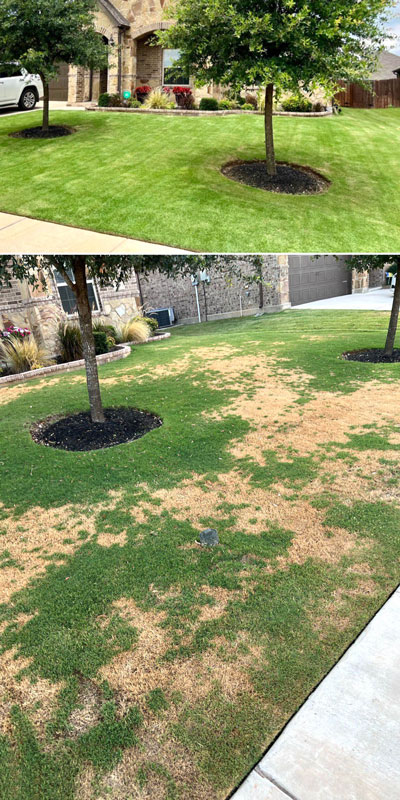
Answer: Your photo shows a textbook example of Pythium blight on bermuda. I see it frequently late each summer, usually in lawns that are very well maintained at high levels of fertilizer and water.
Here is information from Texas A&M.
And here is information from the University of Georgia.
Note that both of these universities refer to some species of Pythium as showing up in cooler weather, but the one that I’ve seen attacking bermuda is definitely a late-summer pathogen. Usually cutting back on the watering and feeding slightly is a big help.
QUESTION 9
WHAT IS HAPPENING TO MY MANDEVILLAS?
Question: What is going on with my mandevillas? The leaves start to turn yellow with green spots on them. Eventually they fall off. It happens every year about this time. It looks like the plants are going to die, but they never do.
Answer: It sounds like the plants may have gotten too dry, especially if the fallen leaves have come from the bottoms of the stems. A photo would have helped.
QUESTION 10
WHY ARE TIPS OF PINE TREES TURNING BROWN?
Question: I have several 4-ft. tall pine trees with browned growing tips. When I pull on them, they come loose easily. A new tree I planted 9 months ago is not showing the problem. What is this? Frank L., Hopkins Co.
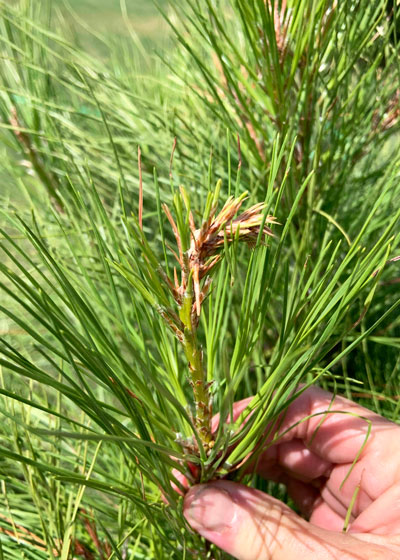
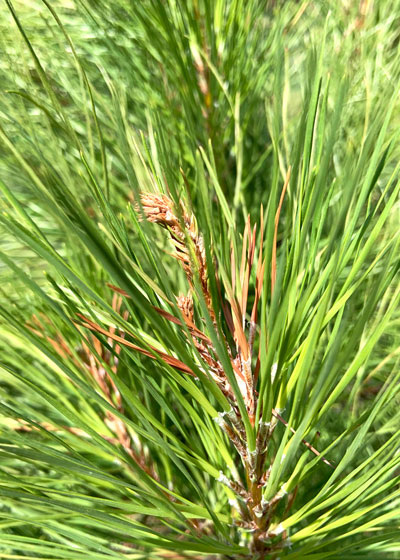
Answer: This looks like damage of the pine tip moth. Here is one publication on the topic from the Texas A&M Forest Service. https://tfsweb.tamu.edu/pine-tip-moth/
You will find many additional articles from other southern Land Grant universities.
QUESTION 11
HOW DO I PRUNE AN OAKLEAF HYDRANGEA?
Question: I have a 10-year-old oakleaf hydrangea that is 6-7 feet tall. Its bottom branches are spindly. Should I prune it really low? It seems healthy and it blooms well. Help, please. Diann Y., Denton.
Answer: I’ve been growing oakleaf hydrangeas for 25 years. We currently have 15 or 20 in our shaded landscape. It’s a great plant. They regrow from pruning quite nicely. Assuming your plant is getting bright light (not necessarily sunlight – just not a dark corner), you could prune it back by 30 or 40 percent. You could probably still do so now so long as you left leaves on each of the stems (not stubs). Follow that up with an application of a high-nitrogen lawn food and a very thorough watering. Or you could do so next spring, but by waiting you would probably sacrifice almost all of next year’s blooms.
QUESTION 12
CAN ST. AUGUSTINE SURVIVE WITHOUT IRRIGATION?
Question: We are under a local mandate not to water our lawns. Will St. Augustine go dormant and come back once rains resume? Jack K., Bryan.
Answer: To my knowledge, few cities have completely forbidden lawn watering entirely. Many have asked their residents to cut back, some dramatically. We all need to check our local regulations carefully to be sure we both understand and comply. In answer to your question, if St. Augustine turns completely brown, no, it will not come back. It has no rhizomes (underground stems) like bermuda does, so it has no rebounding power. Try to figure a way to use recycled dishwater and clothes-washing water to irrigate it if you must. Try your best to keep it at least modestly green.
QUESTION 13
WHY WOULD A DRIFT ROSE STALL OUT IN THE SUMMER IN CENTRAL TEXAS?
Question: I have a large Drift® rose that starts off beautifully in early spring. Then the leaves turn dull green with a whitish film. Eventually they fall off and the flowering stops. I have tried trimming and spraying it, but nothing helps. Advice? Sherry C., Stephenville.
Answer: The white film sounds like powdery mildew. It, and perhaps black spot could cause the plant to lose many of its leaves each summer. Then it is forced to regrow in the fall and again as growth begins in the spring. Look online for photos of black spot and powdery mildew on roses to see if that’s what you were experiencing. If so, start up a spray program this fall and again next spring. Drift® roses are supposed to be resistant to both funguses, so there is a possibility that it was something else. I guess rose rosette virus might even be a consideration. Feel free to include a photo next time.
QUESTION 14
WHY IS SILVERADO SAGE DYING ONE BRANCH AT A TIME?
Question: Why is my Silverado sage dying out one branch at a time? Sonna M., Azle.
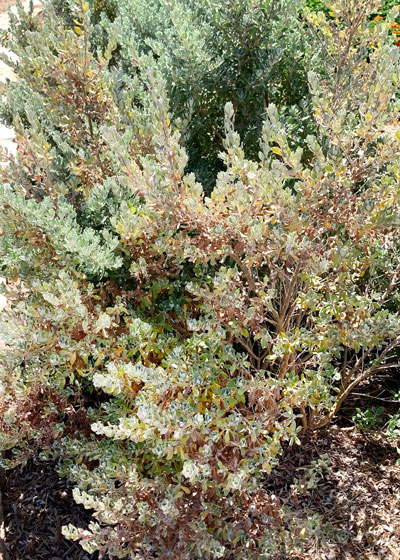
Answer: The plant looks large. That would lead me to believe that it might have been in your landscape in February 2021. Texas sage plants, Silverado and others, were brutalized by the cold that month and they are still showing the effects – similar to what we’re experiencing with some crape myrtles and live oaks. Trace one of the dying branches down to the main trunk to see if you can find any particular clue. My guess is this is just continuing deterioration brought on by freeze damage. You’ll see a great deal of it around DFW (where you live) as you drive around.
